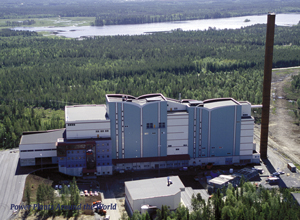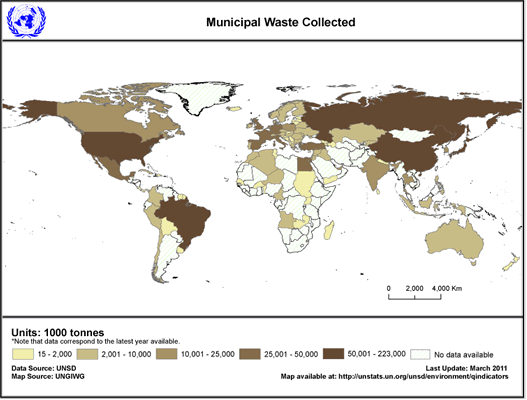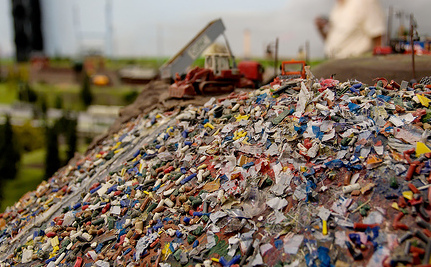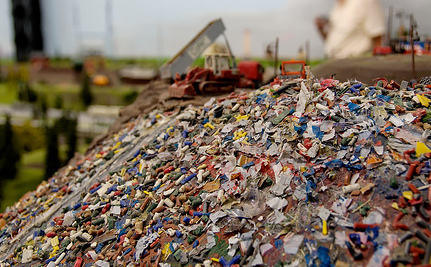My weekend newspaper on its “World” page had some interesting statistics about Sweden and waste-to-energy usage in that country. I learned that biomass generates more energy than oil in Sweden. And that by 2020 the country projects that 50% of all its total energy needs will come from renewable sources. Sweden’s goal is total fossil fuel independence by 2030.
One way the country is achieving this goal is through incineration with recycling programs feeding waste-to-energy power plants of which, currently there are eight throughout the country.

Today in Sweden only 4% of household waste goes to landfill. The remainder is managed as follows:
- 49% is incinerated
- 36% is recycled
- 14% is composted
The 49% consumed by incinerators gets used to generate heat and electricity for buildings and homes throughout the country. Today in Sweden 20% of all homes are heated by hot water and 250,000 homes their electricity, both from burning garbage. As a result Sweden finds itself with not enough garbage from domestic sources to meet energy and heating demand and has started to import waste from other countries. Currently, Norway is the principal supplier, exporting 800,000 tons of its trash to Sweden annually.
Globally waste-to-energy power plants are showing up in a number of countries. But in Europe, Sweden is the only country that consumes other countries garbage to meet its energy demands. Here in North America, where I live, burning garbage for power has not won a large audience. Statistics show there are 459 waste-to-energy power plants in the United States although most are not burning municipal waste. Instead they are dealing with waste from industrial output converting it to energy and heat to supplement manufacturing and mining processes. For those burning municipal waste, many state and municipal governments are not involved having passed the burden along to waste management companies who own private landfill sites and who are contracted to collect and process the waste. These private contractors are finding it harder to develop new landfill sites because of nimby (not-in-my-backyard) opposition. It, therefore, becomes more urgent for them to find alternatives to new landfill sites. Hence they are exploring and in some locations developing incineration or mining of existing waste.
Last week I wrote about the City of Vancouver in British Columbia, Canada, and its announcement to turn 370,000 tons of trash per year into an energy source. It joins a few other municipalities across the the country, most much smaller than Vancouver, using landfill waste to generate energy. Other large Canadian municipalities such as Toronto, Calgary, Edmonton and Montreal continue to baulk at proposals to incinerate municipal waste. Toronto, for many years, has transported and dumped its municipal waste in landfill sites in Michigan, hundreds of kilometers from the city. New York City sends 10,500 tons of its residential waste to landfill sites as far away as Ohio and South Carolina. Sounds ridiculous, doesn’t it?
You would think that with all the waste humans produce that incineration would be a preferred method of managing garbage but that is not the case. Why? Because of effluent concerns — the amount of ash, heavy metals, dioxin, sulphur dioxide, hydrogen chloride, carbon dioxide and other trace gases that burning undifferentiated garbage can produce. These byproducts of incineration are linked to climate change, acid rain, and human illness.

So how is Sweden handling the byproducts of incineration? The country’s incinerators have been designed to collect the pollutants that are the byproducts of burning waste. Residual heavy metals are collected and buried in landfill. Gases going up the smokestack are scrubbed to remove dangerous chemicals. Sulphur dioxide gets converted to sulphuric acid for commercial resale. Ash is collected and exported back to Norway where it gets used for roads and building materials. The goal is to make incineration a green energy source and Sweden is well along the way to achieve this.
Sweden isn’t alone in its pursuit of reducing its landfill to net zero by using garbage as an energy source. Denmark has been in the incineration business much longer and boasts 29 waste-to-energy plants serving 98 municipalities and its 5.5 million inhabitants across the country. Germany and the Netherlands are also in the business of developing incineration plants to convert garbage to energy. For Europe, with far less available land for dumping municipal waste, incineration is seen today as a practical way to achieve two objectives – minimizing the garbage produced and generating the energy needed to heat and light communities while ensuring the process is green.

Some of the biggest resistance to waste-to-energy initiatives comes from environmentalists who want to achieve zero landfill by 100% recycling. This is a noble objective but even in municipalities with high recycling and composting rates garbage continues to be thrown into landfill sites. And legacy landfill sites remain a ticking time bomb – a source of greenhouse gas emissions, and an ongoing environmental hazard.
In the 21st century, how we handle garbage as the population in the Developing World acquires the same material quality of life of those in the Developed World, the problem of municipal waste will get that much larger. Waste-to-energy power plants represent a viable and responsible way to handle what will be an even larger garbage crisis.










(A) “I’m going to investigate further because quite frankly – reduce, reuse, recycle and compost are only partial solutions to managing the waste our 21st century society produces”
ReUse and ReCycleability should be the KEY DESIGN FACTOR on the drawingboard so that a manufacturing process simply does not produce waste in the first place – by default.
In my country there is a waste-recycling-company has a nice slogan that says it all for me “Waste Does Not Exist”
[http://www.vangansewinkelgroep.com/nl/company/afval-bestaat-niet.aspx] Dutch page
(B) “Short of all of us becoming hoarders in our homes to deal with municipal restrictions on what you can throw out, governments have to look at alternatives to landfill.”
I do not want to promote a “Global Minimalistic Lifestyle” here ….but logically seen there is only so much “stuff” that one can use and really needs in a lifetime.
“Landfills are for lamers” that do not want to take the time, research and effort to investigate HOW it is POSSIBLE to turn “waste” BACK into something useful again. and that includes nuclear waste landfills as well.
Mankind can put men on the Moon, send “Rovers” to Mars, launch satellites to other planets and galaxies… but we can not “solve our own earthbound waste challenges”??? Come on…
(C) Another – more advanced solution is working towards “collective ownership”:
Example: A street has 10 houses and 20-30 people living in this.
In the current scenario everyone (old and capable enough) in every household wants to have a (4 seated) car..(to carry only 1 person)… which STANDS STILL most of the time, in front of their houses, and does nothing other than occupying space and flattering their owners ego’s and social status
In a future scenario:
__ The entire street would come together, and CALCULATE FIRST how much shared cars they need, to fulfill their collective transportation needs.
__ They buy (or even lease!) a pool-of-smaller (1,2 person only) cars-per-street and a couple of special-purpose-cars (small trucks)
__ Put all the cars together in a “car-(resources)- pool” and start SHARING these cars with everyone else in the street.
__ When they communicate their collective transportation needs towards each other, maybe it becomes possible that multiple persons are able to SHARE a car (the old car-pooling principle)
With this smaller-car-pool and share-a-car principle:
__ ALL the purchased pool-cars are more used more and efficiently.
__ It provides lower transportation cost/person/street/city
__ Lesser of no traffic jams (of made out of 1 person in one entire car)
__ Better Return On Investment for the car-poolers/car-sharers
__ Fewer environmental pollution
__ Manufactures do not need to make so much cars. (lower resource consumption)
__ (lower CO2 /greenhouse gas emission)
__ Freed up a lot of parking space in the process
__ Freedom for every person to “use-a-car” and go where they want to go
When this “car-pool” is made up of:
__ Electric cars (for relatively short local trips only)
__ Hydrogen powered cars (for medium, long range distances)
__ Carbon fuel cars (for tasks that can not be dove yet by electric powered cars)
The air get much cleaner, lower fossile-fuel-demand and we all could be happy 😛 since “shared-transportation-device-ownership” makes “personal-style” transportation available for everyone in the street/area/city.